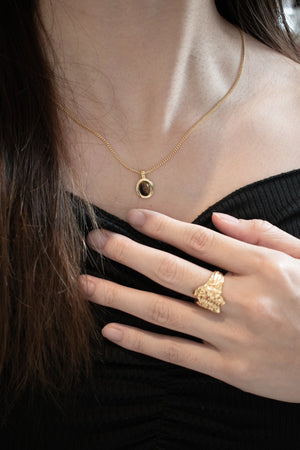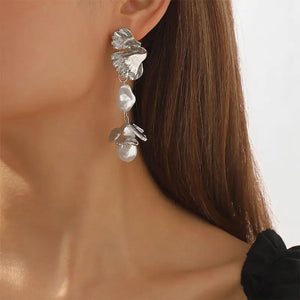Lapis Lazuli is a stunning deep blue gemstone that's been treasured for thousands of years. In ancient times, it was prized for its intense color and believed to have mystical powers. Today, lapis lazuli is still a popular gemstone in jewelry making and is often used as a symbol of wisdom and truth.
However, with the rise of synthetic gemstones in the market, it can be challenging to identify real lapis lazuli from fake ones. That's why today we will learn how to identify real lapis lazuli gemstones and avoid being scammed.
What is Lapis Lazuli?
Before we tell you how to identify real lapis lazuli, it's essential to understand what this gemstone is. Lapis lazuli is a metamorphic rock primarily composed of the mineral lazurite, complemented by calcite and pyrite. It has been used as a gemstone since ancient times and is also known as the "stone of heaven." It is usually found in shades of deep blue with streaks of white and gold. The most valuable lapis lazuli comes from Afghanistan but can also be found in other parts of the world.
How to Identify Real Lapis Lazuli Gemstones
Check the Color
The first thing you should look for when identifying real lapis lazuli is its color. Real lapis lazuli will have a deep, vibrant blue color with visible white and gold flecks. The color should be consistent throughout the stone, with no obvious variations or discolorations. If the gemstone is too light, it may indicate that it is a fake or low-quality lapis lazuli.
So when buying lapis lazuli, be sure to check the color carefully and avoid stones that have a dull or faded appearance. You can also use a loupe or magnifying glass to look closer at the color and check for inconsistencies. If the gemstone has a uniform and intense blue color, it's most likely genuine lapis lazuli.
Look for Inclusions
Inclusions are natural imperfections found in gemstones that can help distinguish genuine lapis lazuli from fake ones. Natural lapis lazuli will have a few visible inclusions, such as tiny crystals or veining caused by the presence of other minerals. These inclusions may appear as white or gold flecks within the gemstone and add to its unique character.
On the other hand, synthetic lapis lazuli or imitations made with dyed materials will usually have no inclusions at all. So, if you can't spot any inclusions in the gemstone, it's likely not real lapis lazuli.
I saw many lapis lazuli advertisements with a deep blue color but lacked any inclusions. Beware of such advertisements and always check for natural imperfections in the gemstone.
Conduct a Scratch Test
Another way to identify genuine lapis lazuli is by conducting a scratch test. This test involves scratching the gemstone against a harder material, such as glass or metal. Real lapis lazuli will not get scratched easily, as it has a Mohs hardness of 5 to 6.
However, if the gemstone gets easily scratched or damaged, it is most likely an imitation or low-quality lapis lazuli. It's essential to note that this test should be done cautiously and only on a small part of the gemstone to avoid damaging it.
Check for Weight and Density
Natural lapis lazuli is a relatively heavy gemstone with a specific gravity of 2.7 to 2.9. If the gemstone feels too light or heavy for its size, it may indicate that it's not natural lapis lazuli. You can also compare the weight of the gemstone to other known lapis lazuli stones to get a better idea.
Additionally, you can also check the density of the gemstone by submerging it in water. Genuine lapis lazuli will sink in water due to its high density, while fake ones or imitations may float.
Seek Professional Help
If you still need to figure out the authenticity of a lapis lazuli gemstone, it's always best to seek professional help from a reputable gemologist. They have specialized tools and knowledge to determine whether a gemstone is real or fake accurately. They can also provide a certificate of authenticity, which is essential when buying higher-priced lapis lazuli gemstones.
Conclusion
Real lapis lazuli gemstones are not only beautiful but also valuable. Therefore, it's crucial to know how to identify them correctly to avoid being scammed.
By following these tips mentioned above, you can ensure that the lapis lazuli gemstone you're purchasing is real and of high quality.
So next time you come across a lapis lazuli gemstone, remember to check its color, inclusions, hardness, weight, and density.
FAQs
1. What is the spiritual significance of lapis lazuli?
Lapis lazuli has been revered throughout history for its purported spiritual qualities. It is often associated with truth, wisdom, and inner peace. Wearing or meditating with lapis lazuli can enhance mental clarity, facilitate self-awareness, and foster a deeper connection to one's higher self.
2. Can lapis lazuli change color over time?
While lapis lazuli is a durable stone, exposure to strong sunlight or harsh chemicals can cause its surface to fade or change color over time. It's best to keep lapis lazuli away from prolonged periods in direct sunlight and avoid contact with household cleaners or beauty products.
3. How can I clean and care for my lapis lazuli jewelry?
To maintain the luster of your lapis lazuli jewelry, clean it gently with a soft, damp cloth. Avoid using ultrasonic cleaners or chemical cleaners, as they can damage the gemstone. Store lapis lazuli pieces separately from other jewelry to prevent scratches and knocks.
4. Is lapis lazuli suitable for everyday wear?
Lapis lazuli has a Mohs hardness of 5 to 6, making it relatively durable but susceptible to scratching. While it can be worn daily, it's advisable to take extra care to protect it from scratches, mainly if it's set in rings or bracelets that come into contact with hard surfaces.
5. Where are the best sources of lapis lazuli found?
The most esteemed source of high-quality lapis lazuli is Afghanistan, where the stone has been mined for thousands of years. Other sources include Chile, Russia, and the United States, each producing stones that may vary slightly in color and inclusion characteristics.




